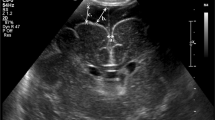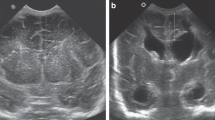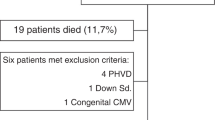Abstract
Objective:
To assess the relationship between ventricular index (VI) measurements and postmenstrual age in preterm infants and to generate centile charts and normal ranges for frontal horn ratio (FHR) for a large contemporary cohort of preterm infants.
Study Design:
A retrospective cohort study of 253 infants with birth gestation less than 32 weeks admitted between January 2009 and December 2011 to a tertiary NICU in Ireland.
Results:
A total of 816 cranial ultrasounds were reviewed. Data collected were grouped according to postmenstrual age at the time of scan from 23 weeks to 45 weeks. Median values for VI show a general trend to increase with gestation. FHR did not significantly change with postmenstrual age at scan with a median value of 0.31.
Conclusion:
There is a slight increase in VI as gestation at the time of scans increases. These results provide the basis for updated centile charts which we propose for current practice.
This is a preview of subscription content, access via your institution
Access options
Subscribe to this journal
Receive 12 print issues and online access
$259.00 per year
only $21.58 per issue
Buy this article
- Purchase on Springer Link
- Instant access to full article PDF
Prices may be subject to local taxes which are calculated during checkout





Similar content being viewed by others
References
Whitelaw A, Cherian S, Thoresen M, Pople I . Posthaemorrhagic ventricular dilatation: new mechanisms and new treatment. Acta Paediatr Suppl 2004; 93 (444): 11–14.
Murphy BP, Inder TE, Rooks V, Taylor GA, Anderson NJ, Mogridge N et al. Posthaemorrhagic ventricular dilatation in the premature infant: natural history and predictors of outcome. Arch Dis Child Fetal Neonatal Ed 2002; 87 (1): F37–F41.
de Vries LS, Liem KD, van Dijk K, Smit BJ, Sie L, Rademaker KJ et al. Early versus late treatment of posthaemorrhagic ventricular dilatation: results of a retrospective study from five neonatal intensive care units in The Netherlands. Acta Paediatr 2002; 91 (2): 212–217.
Soul JS, Eichenwald E, Walter G, Volpe JJ, du Plessis AJ . CSF removal in infantile posthemorrhagic hydrocephalus results in significant improvement in cerebral hemodynamics. Pediatr Res 2004; 55 (5): 872–876.
van Alfen-van der Velden AA, Hopman JC, Klaessens JH, Feuth T, Sengers RC, Liem KD . Cerebral hemodynamics and oxygenation after serial CSF drainage in infants with PHVD. Brain Dev 2007; 29 (10): 623–629.
Levene MI . Measurement of the growth of the lateral ventricles in preterm infants with real-time ultrasound. Arch Dis Child 1981; 56 (12): 900–904.
Rennie J . Neonatal Cerebral Ultrasound. 1st edn Cambridge University Press: Cambridge, 1997.
Harvey CJ, Pilcher JM, Eckersley RJ, Blomley MJ, Cosgrove DO . Advances in ultrasound. Clin Radiol 2002; 57 (3): 157–177.
Fanaroff AA, Hack M, Walsh MC . The NICHD neonatal research network: changes in practice and outcomes during the first 15 years. Semin Perinatol 2003; 27 (4): 281–287.
Helmke K, Winkler P . Sonographically determined normal values of the intracranial ventricular system in the first year of life. Monatsschr Kinderheilkd 1987; 135 (3): 148–152.
Govaert P, de Vries LS . An atlas of neonatal brain sonography. 2nd edn Mac Keith Press: London, 2010.
Brouwer MJ, de Vries LS, Groenendaal F, Koopman C, Pistorius LR, Mulder EJ et al. New reference values for the neonatal cerebral ventricles. Radiology 2012; 262 (1): 224–233.
Brouwer MJ, de Vries LS, Pistorius L, Rademaker KJ, Groenendaal F, Benders MJ . Ultrasound measurements of the lateral ventricles in neonates: why, how and when? A systematic review. Acta Paediatr 2010; 99 (9): 1298–1306.
Sondhi V, Gupta G, Gupta PK, Patnaik SK, Tschering K . Establishment of nomograms and reference ranges for intra-cranial ventricular dimensions and ventriculo-hemispheric ratio in newborns by ultrasonography. Acta Paediatr 2008; 97 (6): 738–744.
Maunu J, Parkkola R, Rikalainen H, Lehtonen L, Haataja L, Lapinleimu H PIPARI Group. Brain and ventricles in very low birth weight infants at term: a comparison among head circumference, ultrasound, and magnetic resonance imaging. Pediatrics 2009; 123 (2): 617–626.
Randomised trial of early tapping in neonatal posthaemorrhagic ventricular dilatation. Ventriculomegaly Trial Group. Arch Dis Child 1990; 65 (1 Spec No): 3–10.
Randomised trial of early tapping in neonatal posthaemorrhagic ventricular dilatation: results at 30 months. Ventriculomegaly Trial Group. Arch Dis Child Fetal Neonatal Ed 1994; 70 (2): F129–F136.
de Vries L, Brouwer AJ, Groenendaal F . Posthaemorrhagic ventricular dilatation: when should we intervene? Arch Dis Child Fetal Neonatal Ed 2013; 98 (4): F284–F285.
Liao MF, Chaou WT, Tsao LY, Nishida H, Sakanoue M . Ultrasound measurement of the ventricular size in newborn infants. Brain Dev 1986; 8 (3): 262–268.
Davies MW, Swaminathan M, Chuang SL, Betheras FR . Reference ranges for the linear dimensions of the intracranial ventricles in preterm neonates. Arch Dis Child Fetal Neonatal Ed 2000; 82 (3): F218–F223.
Ichihashi K, Iino M, Eguchi Y, Uchida A, Honma Y, Momoi M . Difference between left and right lateral ventricular sizes in neonates. Early Hum Dev 2002; 68 (1): 55–64.
Batton DG, Swails TL . Isolated lateral ventricular asymmetry in very low-birth-weight infants: a left-sided lesion? Am J Perinatol 1998; 15 (3): 183–186.
Zagzebski JA . Essentials of Ultrasound Physics. Mosby-Year Book Inc.: St. Louis, MO, 1996; 46–123.
Peng W, Zhu H, Shi H, Liu E . Volume-targeted ventilation is more suitable than pressure-limited ventilation for preterm infants: a systematic review and meta-analysis. Arch Dis Child Fetal Neonatal Ed 2014; 99 (2): F158–F165.
Wong D, Abdel-Latif M, Kent A, Network N . Antenatal steroid exposure and outcomes of very premature infants: a regional cohort study. Arch Dis Child Fetal Neonatal Ed 2014; 99 (1): F12–F20.
Shooman D, Portess H, Sparrow O . A review of the current treatment methods for posthaemorrhagic hydrocephalus of infants. Cerebrospinal Fluid Res 2009; 6: 1.
Brouwer AJ, Brouwer MJ, Groenendaal F, Benders MJ, Whitelaw A, de Vries LS . European perspective on the diagnosis and treatment of posthaemorrhagic ventricular dilatation. Arch Dis Child Fetal Neonatal Ed 97 (1): F50–F55.
Ment LR, Allan WC, Makuch RW, Vohr B . Grade 3 to 4 intraventricular hemorrhage and Bayley scores predict outcome. Pediatrics 2005; 116 (6): 1597–1598 author reply 8.
Wilson-Costello D, Friedman H, Minich N, Fanaroff AA, Hack M . Improved survival rates with increased neurodevelopmental disability for extremely low birth weight infants in the 1990s. Pediatrics 2005; 115 (4): 997–1003.
Moore T, Hennessy EM, Myles J, Johnson SJ, Draper ES, Costeloe KL et al. Neurological and developmental outcome in extremely preterm children born in England in 1995 and 2006: the EPICure studies. BMJ 2012; 345: e7961.
Jonsdottir GM, Georgsdottir I, Haraldsson A, Hardardottir H, Thorkelsson T, Dagbjartsson A . Survival and neurodevelopmental outcome of ELBW children at 5 years of age: comparison of two cohorts born 10 years apart. Acta Paediatr 2012; 101 (7): 714–718.
Adams-Chapman I, Hansen NI, Stoll BJ, Higgins R . Neurodevelopmental outcome of extremely low birth weight infants with posthemorrhagic hydrocephalus requiring shunt insertion. Pediatrics 2008; 121 (5): e1167–e1177.
Acknowledgements
This research received no specific grant from any funding agency in the public, commercial or not-for-profit sectors.
Author Contributions
MB: Dr Boyle conceptualized and designed the study, carried out analysis of data, drafted the initial manuscript and approved the final manuscript as submitted. RS: Ms Shim collected data, carried out analysis of data, critically reviewed the manuscript and approved the final manuscript as submitted. RG: Mr Gnanasekaran collected data, carried out analysis of data, critically reviewed the manuscript and approved the final manuscript as submitted. AT: Dr Tarrant coordinated and supervised data collection; training of data collectors, acquired ultrasound images, critically reviewed the manuscript and approved the final manuscript as submitted. SR: Dr Ryan coordinated and supervised data collection; training of data collectors, acquired ultrasound images, critically reviewed the manuscript and approved the final manuscript as submitted. AF: Dr Foran conceptualized and designed the study, critically reviewed the manuscript and approved the final manuscript as submitted. NM: Prof McCallion conceptualized and designed the study, designed the data collection instruments, coordinated and supervised data collection, critically reviewed the manuscript and approved the final manuscript as submitted.
Author information
Authors and Affiliations
Corresponding author
Ethics declarations
Competing interests
The authors declare no conflict of interest.
Rights and permissions
About this article
Cite this article
Boyle, M., Shim, R., Gnanasekaran, R. et al. Inclusion of extremes of prematurity in ventricular index centile charts. J Perinatol 35, 439–443 (2015). https://doi.org/10.1038/jp.2014.219
Received:
Revised:
Accepted:
Published:
Issue Date:
DOI: https://doi.org/10.1038/jp.2014.219
This article is cited by
-
Ventriculomegaly thresholds for prediction of symptomatic post-hemorrhagic ventricular dilatation in preterm infants
Pediatric Research (2022)
-
Cross-sectional reference values of cerebral ventricle for Chinese neonates born at 25–41 weeks of gestation
European Journal of Pediatrics (2022)



